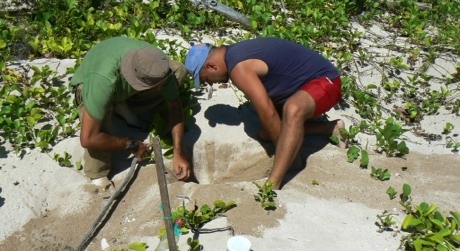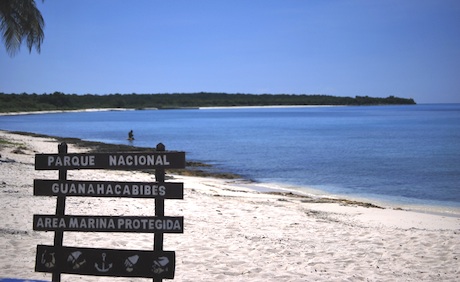SEE Turtles and Cuba Marine Research and Conservation Program (CMRC), a Project of The Ocean Foundation, and the University of Havana’s Center for Marine Research (CIM) collaborate on a sea turtle monitoring and conservation project in Cuba’s Guanahacabibes Peninsula provides key insight into sea turtle populations along the Gulf of Mexico, principally the green (Chelonia mydas) and loggerhead sea turtle (Caretta caret).
Project objectives
Prior to the onset of this project in 1998, there was no comprehensive monitoring of sea turtle populations in the western region of Cuba. The project, which has since become the largest active sea turtle monitoring program in Cuba, has three principal research objectives:
1. To determine principal sea turtle nesting areas in this national park
2. To collect data on the sea turtles, nests and eggs
3. To examine the existing genetic diversity in the populations of marine turtles that nest in the zone and through tagging, gain better insight into how the sea turtle populations of the Gulf of Mexico are related.
Project successes
Over the years the project has involved hundreds of volunteer students and staff. Data collected suggests that a population of up to 2,000 female green turtles uses Guanahacabibes’ beaches as a nesting site. 2013 was a breakthrough year for the project: Almost 900 nests were reported on seven nesting beaches, breaking the previous annual high by a factor of two. This figure confirms a regional trend in which green turtles in Florida and Bahamas also exhibited record nesting figures. These results give CMRC and CIM renewed confidence that they are the consequence of conservation measures employed in the region over the past decades, including restrictions on bycatch, direct poaching and beach lighting ordinances in developed areas in Florida and Mexico.
2014 was, as expected, not as high in green turtle nesting as 2013 (a record setting year). This was expected as sea turtles exhibit a phenomenon called “masting” by which one year turtles will nest in higher numbers than the following year. Scientists believe this evolutionary strategy enhances survival of the species by ensuring that at least in alternating years, hatchlings can migrate en masse to the ocean, thereby confusing predators, or in the least, enhancing the hatchling/predator ratio in a way that makes predation more trivial to that population of hatchlings.
The 2014 season took place from July 3-September 16th. A total of 38 volunteer citizen scientists patrolled a total of 9 beaches.
Your impact
The total number of nesting turtles counted in 2014 was 215, 174 were green turtles and 41 loggerheads. The fact that 41 loggerheads were counted, a figure not seen since the 2006 season, is a positive sign as historically, loggerheads make up only about 3% of the nesting population. Yet in 2014 they made up 18% of the nesting population. Taking into account that loggerhead nesting has seen a small yet gradual rise in recent years, this might suggest that loggerheads are also making a comeback.
A total of 28 turtles were tagged. By increasing the number of tagged animals, the project is able to more precisely determine the size of the population based on the number of turtles who return to Guanahacabibes. Nine of these 28 turtles were identified as turtles previously tagged.
A total of 177 nests were documented and of those nests, 6,488 hatchlings emerged. For what was expected to be a low nesting season, we are pleased with the number of turtles documented this year and look forward to next year which could show new record nesting rates as we saw in 2013.
Our educational activities continued in 2014. A total of four workshops were given by CIM staff at La Bajada, a fishing village located at the entrance of the national park. The workshops are aimed at educating the youth and female members of the town to understand that turtles provide important benefits such as tourism and ecosystem services such as keeping seagrass beds in check and providing a food source for apex predators.

Learn more
For the first time, CMRC had an intern spend time at Guanahacabibes to collect data and document the effort. Yasmina Shah-Esmaeili, a graduate student at the University of Ghent in Belgium, spent three weeks at Guanahacabibes National Park. You can read her blog on our website here.
What’s next?
Yes. This project has defied all conventional wisdom since its inception in 1998. On a very short budget, our research activities have continued uninterrupted with us now completing our 16thnesting season. The project is one that the Cuban government has taken considerable pride in and is an important source of data, perspectives and recommendations to the Cuban National Sea Turtle Working Group. This project is helping piece together the broader Caribbean green turtle picture and will continue its valiant work thanks to donations such as the one from Footprints Network.
Can I visit this project?
Yes! SEE Turtles organizes sea turtle trips to Cuba.
Objectives, Aims, and Outcomes
Objective: To protect the sea turtle nesting beaches in Guanahacabibes National Park, Cuba through monitoring, scientific research, and education of local communities.
Aims:
- To protect sea turtle nests laid here by green and loggerhead turtles (avg. roughly 300 nests/year).
- Conduct a scientific research program that includes intensive monitoring of key beaches within the park.
- Educate nearby communities about the importance of protecting the local turtle population.
- Prevent poaching of nesting female turtles due to presence of researchers.
- Track movements of adult green turtles post nesting.
- Create an effective fine system within Cuba to deter poaching and black market trade of sea turtles, manatees, and black coral.
Outcomes:
- Protect at least 90% of the nests laid in the park. With an average year, that would be roughly 30,000 hatchlings produced during the season.
- Conduct nest surveys throughout the nesting season (May-October) and record data.
- Due to heightened presence of volunteers we expect to see a diminished rate of poaching than in previous years.
- CMRC and CIM scientists to report data at international conferences including International Sea Turtle Symposium
- Educate local community in appreciating the socioeconomic value of a live turtle as opposed to a turtle poached and sold on the black market.

What is covered in project cost
Funding for this project will cover staff costs for managing and monitoring the park’s nesting beaches (approximately 40 local staff and volunteers), as well as transportation to and within the park, and research equipment (including flipper tags and data collection tools). Funds will also be used for meals for staff while at the project.
Project funds will also help to expand the program’s educational outreach. The project has built strong ties with local schools and residents, involving them in the project. With their help, the project has drastically reduced poaching of turtles and their eggs throughout the Guanahacabibes peninsula. The project includes a strong educational component to ensure that local communities such as La Bajada, a fishing village near Guanahacabibes National Park that the project has worked with since 1999, will carry on this work in the future. Funds will also be used to continue educational workshops at the local fishing village of La Bajada. For the past 10 years, these workshops have involved village fishermen, wives and children.
We will continue collecting data on this sea turtle population building on the success of 2013, during which over 900 turtle nests were counted, breaking the historical annual high by a factor of two. In 2014, we will organize a workshop to empower La Bajada’s residents and introduce them to sustainable alternatives to discourage poaching of sea turtles. Another workshop will take place with Cuban agencies in late 2014 to enhance Cuba’s system of fines for poaching. Currently the fine for poaching a sea turtle is much lower than the value the poachers obtain for the animal on the black market. We have agreed with WWF-Cuba to gather Cuban ministerial representatives to revisit Cuba’s sanction system for illegal poaching of marine wildlife.
Background on current situation in this location
In 2014 our joint team will commence its 16th year monitoring nesting female green turtles at seven beaches along the Guanahacabibes Peninsula: beach surveys have been carried out by CIM and University of Havana students during every nesting season (April-October) since 1998. Prior to this work, there was no intensive monitoring of sea turtles in this region of Cuba and illegal poaching was alarmingly high. In 2013, almost 900 new nests were counted along Guanahacabibes’ beaches, breaking previous year’s records by a factor of two.

Project Partners
Cuba Marine Research and Conservation Program (CMRC): This Ocean Foundation project builds strong scientific collaboration between Cuba, the US and neighbouring countries that share marine resources; establish locally-supported marine research and conservation programs; contribute to the scientific understanding and conservation of Cuba’s natural resources; and in the process, help train the next generation of Cuban marine scientists. (See website www.cubamar.org)
Centro de Investigaciones Marinas de la Universidad de la Habana: One of Cuba’s main marine research institutions. An institution that combines research and education, every marine scientist in Cuba earned their degree from CIM. CMRC and CIM have a 15 year history of working together on emerging marine research projects.
How this project fits into a larger strategy
CMRC and SEE Turtles are partnering to create a long-term strategy to make the sea turtle conservation efforts at Guanahacabibes self-financing through ecotourism and volunteer programs. CMRC recently received a State Department permit to start bringing volunteers and tour groups to work at this beach and tour costs will help to cover future project expenses while involving more members of the local community.
Can I visit this project?
Yes! SEE Turtles can help set up volunteers and travellers to visit this project through one of our tour operator partners.